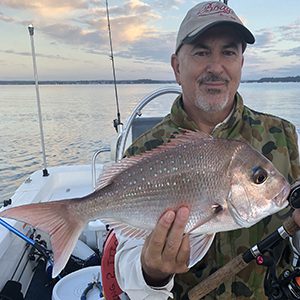
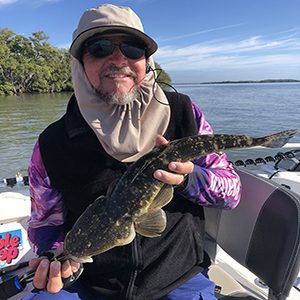
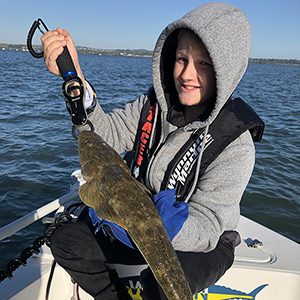
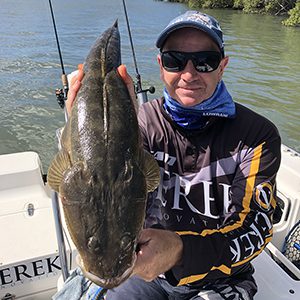
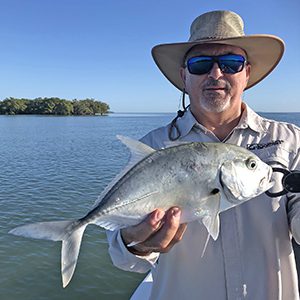
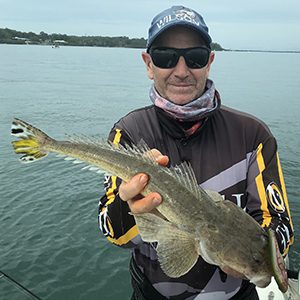
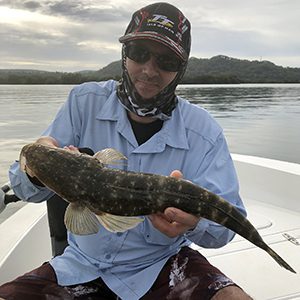
WELL 2020 has been one big rollercoaster but let’s hope things settle and we return to some sort of normality and can all get back to work. I’ve gone from not being able to work at all to finally being allowed to run my charters once more.
We will see how it all goes, we’ve been changing techniques very quickly with this nasty little bug. This at least allows me to get people out on the water and generate some much-needed cash flow for the business while ensuring I put people onto fish. I haven’t had very many clients out but at least when we’ve been on the water the fishing hasn’t been too bad.
The dropping water temperature has seen flathead push up into the shallows more often. Nice squire have turned up around the southern Moreton Bay islands too. The flathead in the shallows have mostly been quite happy to take soft plastics as well as trolled hard-bodies, but at times they can be a little finicky and I’ve had to try a few techniques to get them to bite.
For example, I might be trolling my normal Zerek Bulldog Cranks around an area I’m pretty sure has flatties but am having no success. My thoughts would be there might not be quite enough water depth for the aggressive action of the Bulldog Crank. changing techniques
So to get a reaction out of the fish I need something with a completely different action. This is when I switch to the Zerek Tango Shad, which is a thinner-profile lure with a tighter action. In certain areas I’ve trolled backwards and forwards in an area three or four times with the Bulldog Crank with no luck, then deployed a Tango Shad and hooked up twice in 50m.
This can go the other way too. I could be having no luck with the Bulldog so tie on something like a 2m or 3m-diving Wilson Fish Art lure and troll it in 600mm of water. It will absolutely belt the bottom with a very aggressive action and sometimes this is what’s needed to get a reaction out of the fish. The same principle applies with soft plastics.
Sometimes you can be casting into an area and using a subtle finesse approach with a light jig head and paddle tail or curly grub but you may not get a reaction. If you feel fish are there, I would go up to something like a Zerek Live Flash Minnow Wriggly or Flat Shad and a 1/4oz or 3/8oz jig head and start belting the bottom to see if I can get a reaction out of them.
Don’t assume if you haven’t caught any fish on your first few trolls or casts that no fish are present. Maybe that spot is barren but then again we all know what assume stands for and you could be driving away from good fish. They may just not be attuned to the offering you are showing them. I have seen their preferences change from day to day, so if you’re heading out once or twice a month it’s a lot harder to pick what mood they’ll be in.
If you’ve got a couple of fishos in the boat, try two different techniques at once. Then if one starts working, the other person can change. The squire/snapper around the bay islands have been playing the same sort of game over the past month.
We have been catching them, not in great numbers, but getting a few every time we go out. They too have been taking a variety of techniques. These techniques can change due to the colour of water we are fishing or the size or what part of the tide we are fishing.
Some days after the wind has been up it’s dirty, so I use darker plastics and hard-bodies. Three days later when the water has cleaned up I’ll use brighter colours. On the smaller tides I’ve been returning to bait to chase squire. The point of this article is don’t get locked into one way of targeting fish – try a few different techniques.
Make sure you’re changing techniques for a valid reason, however, don’t just chop and change for the sake of it. For example, when the tide slows I change to bait for targeting snapper, then then when it speeds up I go to lures.
And if the water is dirty I use darker colours but if it’s cleaner I use lighter colours. I might go into more detail next month… As we all know with our jobs and lives, we are time poor, so if you can learn more to optimise your time on the water, then why not? Remember: knowledge is the key.
If you’re interested in any off or on-water tuition classes or you just want to do a charter, don’t be afraid to give me a call on 0432 386 307 or send me an email at seanconlons fishing@hotmail.com
You can also check out the Sean Conlon’s Fishing Charters and Tuition Facebook page.
Until next time…
 Bush ‘n Beach Fishing Magazine Location reports & tips for fishing, boating, camping, kayaking, 4WDing in Queensland and Northern NSW
Bush ‘n Beach Fishing Magazine Location reports & tips for fishing, boating, camping, kayaking, 4WDing in Queensland and Northern NSW









